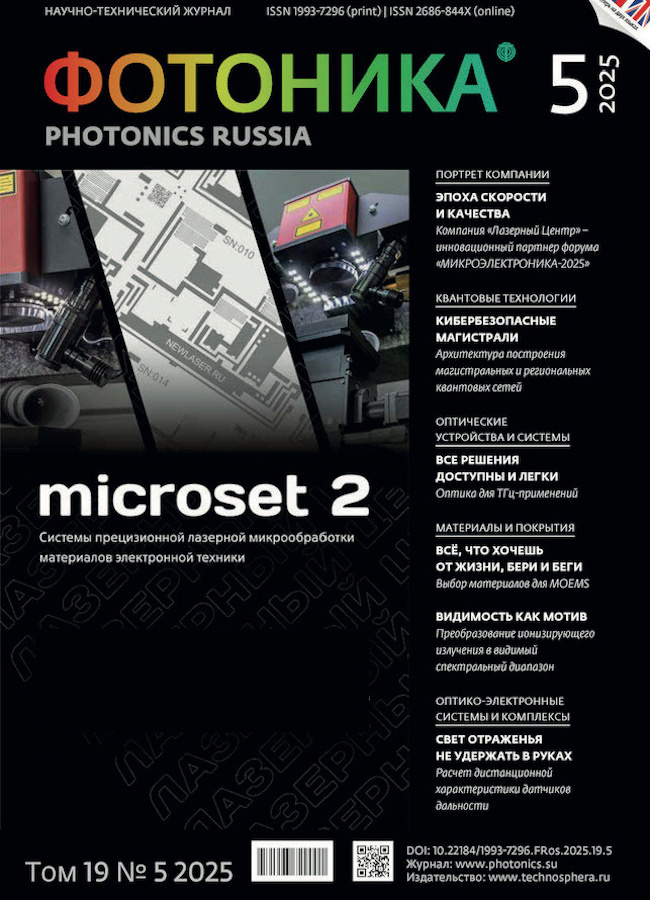Choice of Materials for Creating Micro-Opto-Electromechanical Switches for Next-Generation Communication Systems
- Authors: Dryagin I.O.1, Manin A.N.1, Gorshkova A.P.1, Istomina N.L.1
-
Affiliations:
- Moscow Aviation Institute
- Issue: Vol 19, No 5 (2025)
- Pages: 400-407
- Section: Materials and Coatings
- URL: https://journals.eco-vector.com/1993-7296/article/view/690098
- DOI: https://doi.org/10.22184/1993-7296.FRos.2025.19.5.400.406
- ID: 690098
Cite item
Abstract
The paper discusses the selection of materials for micro-opto-electromechanical switches (MOEMS) used in new generation communication systems. The focus is on the optical and electrical characteristics of materials, such as dielectric permittivity, refractive index, and bandgap. A study of the effect of these parameters on the efficiency of optical systems is carried out. Machine learning methods were used to predict the properties of materials, and promising materials with high dielectric permittivity were identified. The results obtained can be useful in the development of new methods for designing optical and radio-frequency communication components.
Full Text
About the authors
Ivan O. Dryagin
Moscow Aviation Institute
Author for correspondence.
Email: ivandryagin@yandex.ru
ORCID iD: 0000-0002-4545-2305
Senior Lecturer at the Department of Innovation Management (317)
Russian Federation, MoscowAndrey N. Manin
Moscow Aviation Institute
Email: ivandryagin@yandex.ru
Technician at the Department of Innovation Management (317)
Russian Federation, MoscowAlina P. Gorshkova
Moscow Aviation Institute
Email: ivandryagin@yandex.ru
Technician at the Department of Innovation Management (317)
Russian Federation, MoscowNatalia L. Istomina
Moscow Aviation Institute
Email: ivandryagin@yandex.ru
ORCID iD: 0000-0001-6008-1226
Dr. of Sc. (Phys. & Math.), Professor at the Department of Innovation Management (317)
Russian Federation, MoscowReferences
- Demidov A. A., Rybalka S. B. Modern and promising semiconductor materials for microelectronics of the next decade (2020-2030). Applied Mathematics & Physics. 2021; 53(1): 53-72 (in Russian). doi: 10.52575/2687-0959-2021-53-1-53-72.
- Loiko P. A., Yumashev K. V., Kuleshov N. V., Pavlyuk A. A. Measurement of the temperature coefficient of the refractive index by the method of deflection of the laser beam in the medium with a linear temperature gradient. Devices and methods of measurements. 2010;1:70-77.
- Konov K., Perfilyev V. Analysis of the Propagation of a Short Radio Pulse in Media with Negative Permittivity. International Seminar on Electron Devices Design and Production (SED). Prague. Czech Republic. 2021; 1-4. doi: 10.1109/SED51197.2021.9444526.
- Ushakov O. K., Chuguy Y. V. Specialized Instrument Engineering, Metrology, Thermal Physics, Microtechnics. – Novosibirsk: SGGA, 2007. – 268 p.
- Klimov K. N., Konov K. I., Belevtsev A. M., Epaneshnikova I. K., Boldyreff A. S. Electromagnetic Modeling of the Ultra-Wideband Antenna Array Radiator. Radiation and Scattering of Electromagnetic Waves (RSEMW). Divnomorskoe. Russian Federation. 2023; 232-235. doi: 10.1109/RSEMW58451.2023.10202018.
- Vysokikh D. K., Pukhov A. A., Kulikova D. P. et al. Surface Dielectric Permittivity of Superthin Layers. Modern electrodynamics. 2024;5(13):4-13. doi: 10.24412/2949-0553-2024-513-04-13. – EDN YTQUYD.
- Valiev A. I., Lysenkova S. A. Application of Machine Learning Methods for Automation of the Process of Text Content Analysis. Bulletin of Cybernetics. 2021; 4(44):12-15. doi: 10.34822/1999-7604-2021-4-12-15. – EDN IRNNVG.
- Klimkov Yu. M., Mayorov V. S., Khoroshev M. V. Interaction of Laser Radiation with Matter. – Moscow: Moscow State University of Geodesy and Cartography, 2014. - 108 p.
- Databases. URL: https://www.totalmateria.com/ru/
- Maglione M., Vikhnin S., Liu G. K. Polarons, free charge localisation and effective dielectric permittivity in oxides. Springer Series of Topics in Solid-State Sciences, Springer Verlag. 2010, Topics in Solid-State Sciences. HAL Id: hal-00493298. URL: https://hal.science/hal-00493298v1
- Kadera P., Lacik J., Arthaber H. Effective Relative Permittivity Determination of 3D Printed Artificial Dielectric Substrates Based on a Cross Unit Cell Radioengineering. 2021. December;30(4):595-610. doi: 10.13164/re.2021.0595.
Supplementary files













